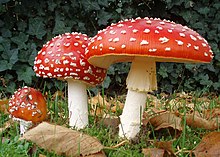Fly agaric

Fly agaric (Amanita muscaria) is a poisonous and psychoactive mushroom, one of many in the genus Amanita. Native throughout the temperate and boreal regions of the Northern Hemisphere, this mushroom has been unintentionally introduced to many countries in the southern hemisphere, generally as a symbiont with pine plantations, and is now a true cosmopolitan species.
The quintessential toadstool, it is a large white-gilled, white-spotted, usually deep red mushroom, one of the most recognizable and widely encountered in popular culture. Although it is generally considered poisonous, deaths from its consumption are extremely rare, and it is eaten as a food in parts of Europe, Asia, and North America after parboiling. Amanita muscaria is noted for its hallucinogenic properties, with its main psychoactive constituent being the compound muscimol. It was used as an intoxicant and entheogen by the peoples of Siberia and has a religious significance in these cultures. There has been much speculation on traditional use of this mushroom as an intoxicant in places other than Siberia; however, such traditions are far less well documented. It has for instance been suggested that the fly agaric was an ingredient of Soma and that it played a role in the Eleusinian Mysteries as well as early Christianity.
Related pages[change | change source]
Other websites[change | change source]
- Webpages on Amanita species by Tulloss and Yang Zhuliang
- Amanita on erowid.org
- Aminita muscaria, Amanita pantherina and others (Group PIM G026) by IPCS INCHEM
